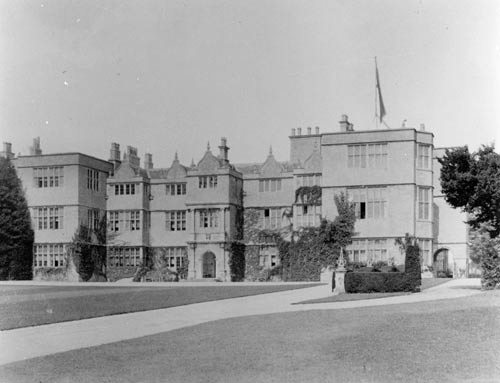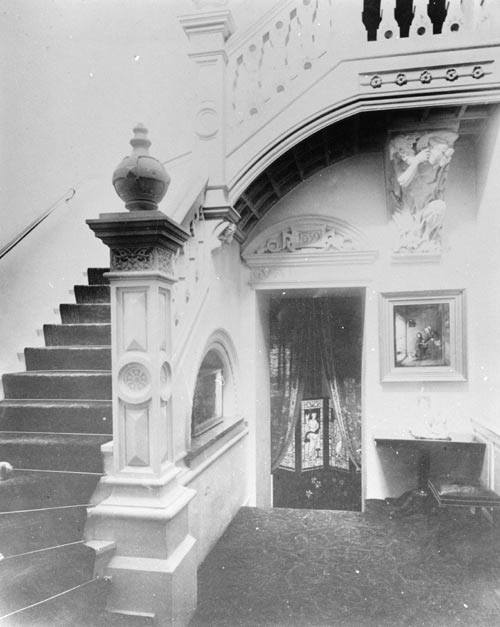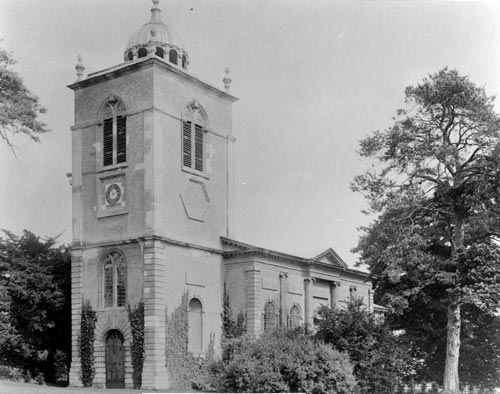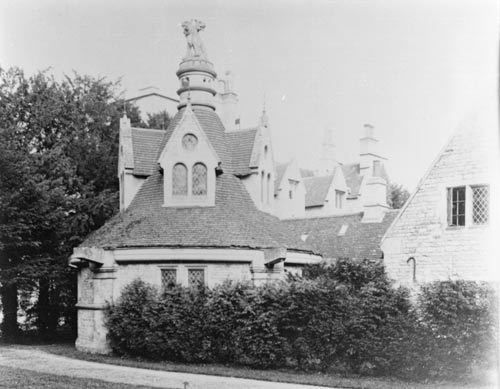GAYHURST HOUSE

THE HISTORY OF GAYHURST HOUSE AND THE ADJACENT BUILDINGS
This article is taken from "Gayhurst: A Study of the Park and Gardens" by Janet Jack and is reproduced here with her kind permission.
GAYHURST HOUSE

THE HISTORY OF GAYHURST HOUSE AND THE ADJACENT BUILDINGS
Gayhurst House is a beautiful example of an Elizabethan stone mansion. With its stables and service buildings, now converted into houses, and the parish church, it forms a fine group in the landscape. It has a timeless, inevitable character created by the quality and colour of the stone of the buildings and their landscape setting.
There are many descriptions of the house and its evolution, some contradicting others, but it was clearly built in three different periods, Tudor, Elizabethan and Queen Anne, with Victorian additions.
The Tudor Period
According to Thomas Wright, the Nevills, who owned Gayhurst from 1408 to 1581, probably built the oldest part of the existing house in about 1500. It is the rectangular southern wing of the house facing south-west. Thomas Wright comments:
"...although greatly altered at various times, the position of its front door and entrance-hall can be easily pointed out. ...This old building abounds in narrow passages, thick walls, quaintly formed and unexpected roofs and gables. ...Each of the many gables forms a room, and odd little rooms they are. ...There were numerous and strange projections, and tall stacks of chimneys contrived to mask secret chambers and hiding places... "
The Elizabethan Period
Again according to Thomas Wright, William Mulso started the next phase of building in 1597. It took the form of an E: using the old house as the bottom wing, entering by a porch on the south-east on the short central leg of the E, thus he greatly enlarged the house and completely changed the orientation, from facing south-west to facing south-east. Thomas Wright tells us that the old south wing was used by the family and the north wing, with its own porch and entrance, was reserved for special visitors: "Directly in front of his porch, Mulso built a massive gateway.
There are two doorways, c.1520, in the cellar of the north-west part of the house indicating that it was built on top of the older house. This information conflicts with Thomas Wright's description of the shape of the Tudor house. In Victoria County History: Buckinghamshire published in 1914, it is given a different description which appears logical and could be accurate, except that the orientation of the house is given incorrectly. Without correction and a diagram to explain it, it is quite misleading. The confusion arises because, although the axes of the house are at 45 degrees to north/south, east/west, the house is described as having north, south, east and west facades, which it does not have. When corrected it can be understood as follows.
Tudor Phase
1. Early 16th century.
2. L shaped, with the long upper arm facing north-west and the shorter southern block facing south-west and north-east.
Elizabethan - Jacobean Phase
1. End of 16th century. Begins to assume its present form.
2. Long arm of L removed, (presumably the cellars were kept).
3. Extensive additions made north-east of original block which was retained to form the southern (lower) arm of the E shaped Building.
4. Work probably done by Sir Everard Digby, starting in 1597, one year after his marriage and continued by his son Kenelm, born 1603 (and presumably his wife), after he was executed in 1606.
It is relevant to try to establish Kenelm Digby's involvement in alterations and improvements to the property as he was well-travelled and must have been inspired by the Renaissance architecture he had seen in Italy and France during his exile after 1642. In Victoria County History he is credited for the completion of the flanking wings of the house "Between the hall and anteroom is a moulded stone archway flanked by Corinthian pilasters, and having in the panelled soffit the monogram K.D., doubtless for Kenelm Digby, to whom this work is to be attributed. It also describes the walls of the peacock room, which is on the first floor of the same wing as being "...covered with hand painted leather, probably of the 17th century, ornamented with designs of peacocks, parrots, and other birds, and branches of trees”.
South of the house are the former service wing and dovecote, in a row, stretching towards the south-east. They were built in the 17th century and have some 19th century additions. Together with the church they form a very deliberate forecourt to the main facade of the building but this could not have been achieved until the rectory opposite the old church had been demolished and moved to Stoke Goldington.
The Queen Anne Period
George Wrighte, 1677-1724, bought the property in 1704. He filled in the large space between the limbs of the E on the north-west side of the house. His additions included the ballroom above the dining room, a grand staircase, and alterations to the hall. As described in Victoria County History, on the north-west front of the house
"...the central portion of which is of two stories only, surmounted by a dentil cornice and ball finials, has a central doorway, and is lighted by rectangular windows (those on the first floor having alternate pointed and curved pediments) and two Venetian windows."
The Stone Staircase

The second George Wrighte rebuilt the old church in 1728 on the previous mediaeval foundations, four years after his father's death, in accordance with his will. It is thought of very highly. Victoria County History reports as follows: "It is built of sandstone ashlar, faced externally and plastered internally. ...It was constructed in the prevailing classic Renaissance manner, and is an excellent example of work of that period..."Thomas Wright, among others, wrote that it was "in all probability the last of the works of Sir Christopher Wren, which eminent architect, although he gave the plans for the church, never saw it finished, dying in 1723, in his ninety-second year. "Pevsner on the other hand, says "The architect is unknown but he praises the monument in the church, of Sir Nathan Wrighte and his son as being "...work of...startlingly high quality." The lead cupola of the church over the bell tower at the southern end is a delicate design which is a landmark in the countryside.
Gayhurst Church

(Click here for a more detailed study of St Peter's Church, Gayhurst)
The Victorian Period
Lord Carrington signed a 21-year repairing lease in 1856 which allowed him to do extensive interior alterations. He engaged the services of William Surges, A.R.A... the architect of high Victorian romanticism, to carry out alterations to reception rooms, bedrooms, fireplaces and the kitchen. Carrington was Burges's first major client and he was grateful for the commission which he carried out with vigour, turning the kitchen into a mediaeval refectory and building a servants outside lavatory block as a highly modelled circular folly, This was crowned by a bold, stone statue of Cerebus with red glass eyes in each of its three heads. J. Mordaunt Crook in William Burges and the High Victorian Dream describes it as:
"One of the most curious lavatories ever built... Carrington's Privy was surely one of Burges's happiest inventions: a picturesque convenience, dedicated to a cloacal demon with billiard-ball eyes, for a patron with plumbing on the
Male Servants Lavatory

In the Abbess's Room he had wall panels painted with birds, fruit and flowers by Frederick Smallfield, see 1993 photograph, the idea being taken from Catherine de Medici's boudoir at the Chateau of Blois. Additions were made to the service wing to the south of the house by Surges at the same time. Unfortunately some of Burges' work has not survived the events at Gayhurst since 1950.
GAYHURST TODAY
Gayhurst House and Cuurch

The redevelopment of Gayhurst House and its outbuildings was undertaken in the 1970’s when the whole site was purchased by developers. Obviously the builders had to respect the fact that they were dealing with a Grade One listed building. As a consequence the exterior façade is virtually unchanged.
(Click here for The Estate Agents portfolio giving details of the various apartments and Mews Houses that were available)
|
If you came to this page via a Web search engine
Click here for the full Gayhurst feature pages |